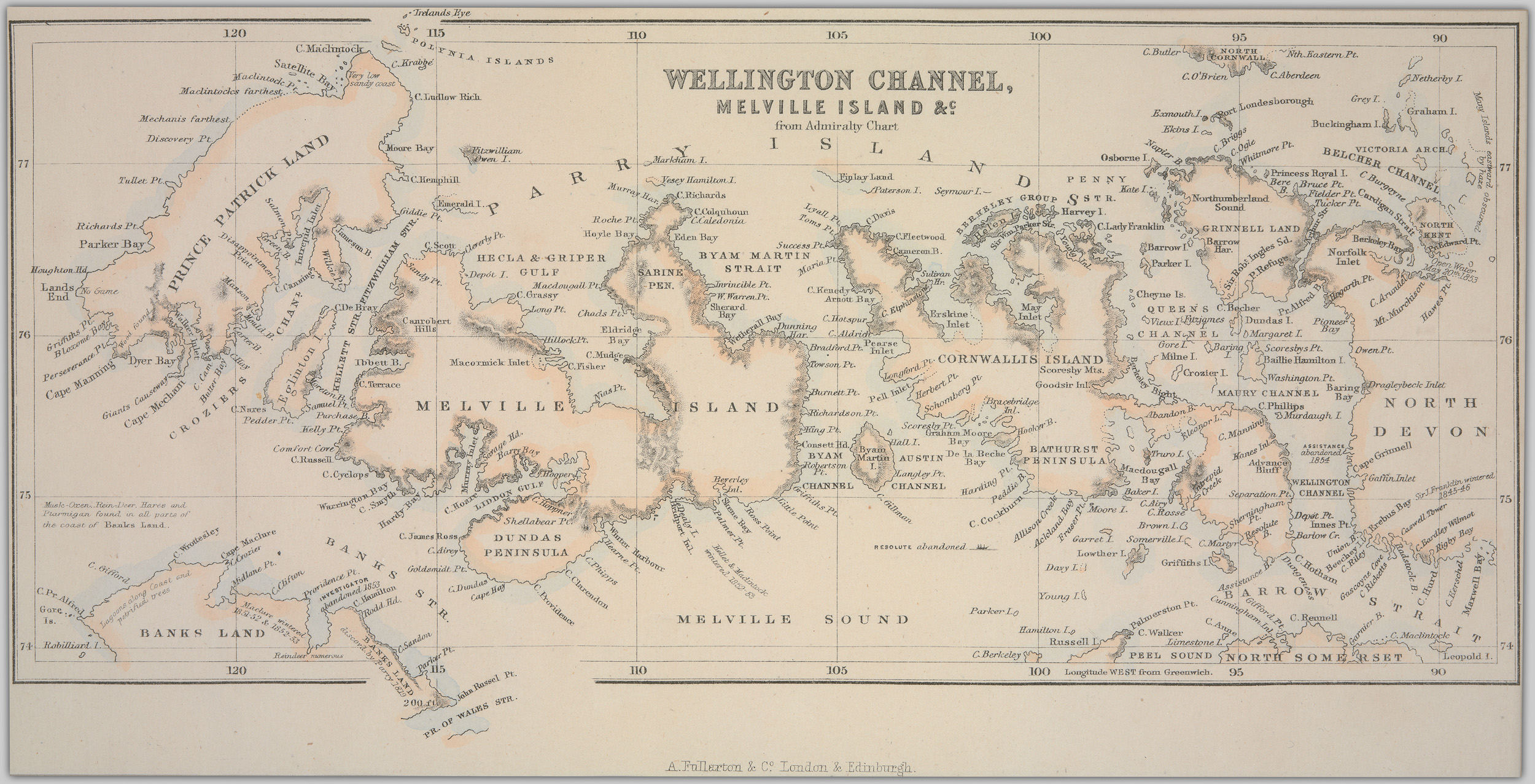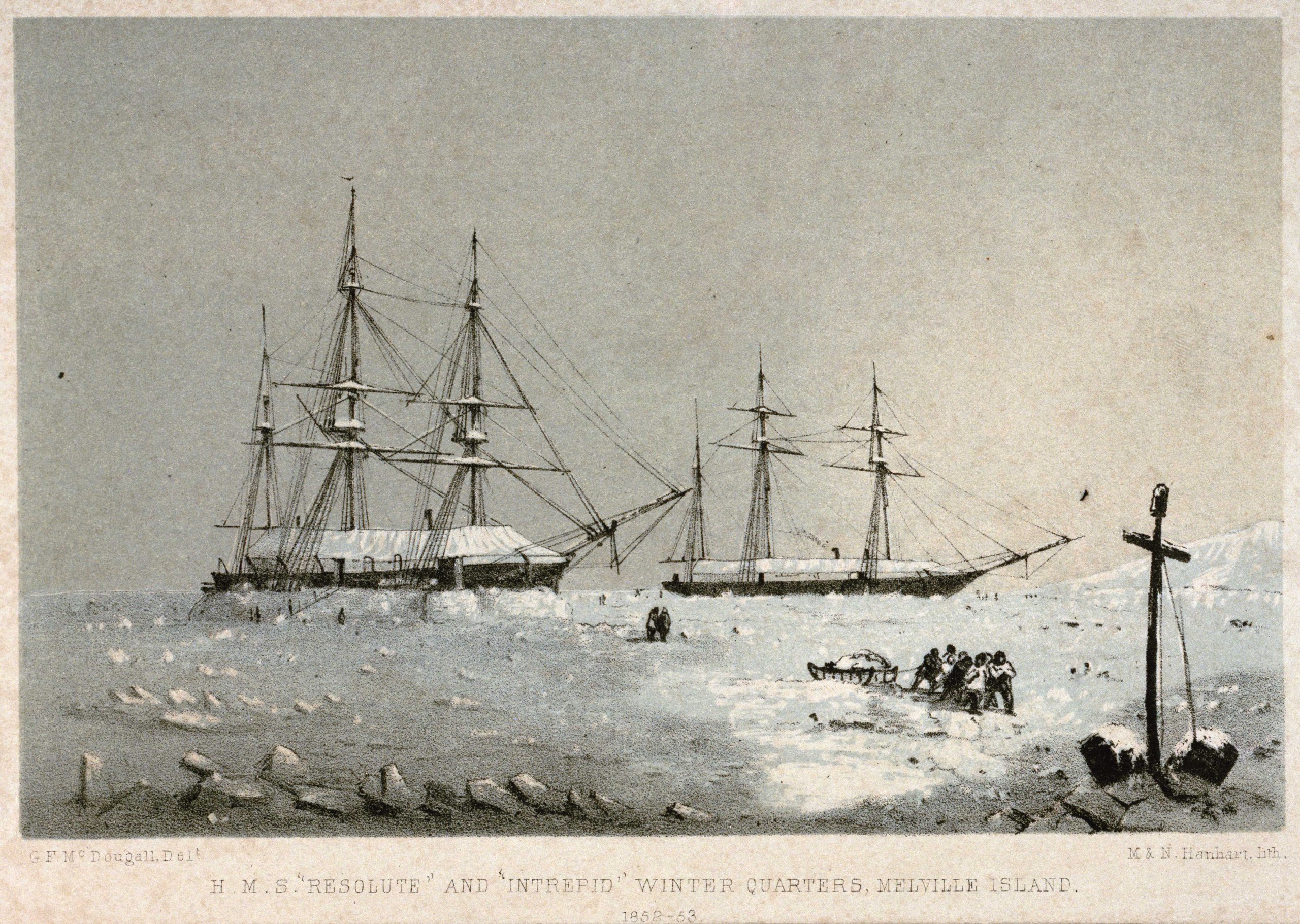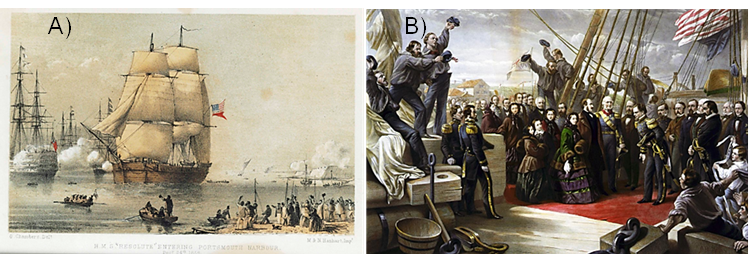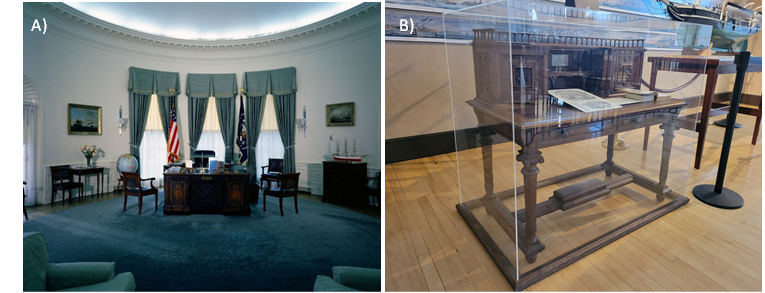Ghost ships have no living crew aboard – they may be fictional, or a derelict found floating with crew dead or missing. They may be based on folklore or mythology or unexplained strange events, such as HMS Eurydice, or on unsubstantiated rumours. But they can also be based on historical events, often abandoned ships witnessed in some way, and volunteer Roger Burns uncovers the epic events surrounding one of the latter category, HMS Resolute.
The purpose of Resolute’s mission predates its launch, the mission being to join a squadron to search for the naval ships, Terror and Erebus commanded by Captain Sir John Franklin, and which had left Chatham in 1845 for the Northwest Passage but had never returned. There were other expeditions, from both the UK and America, with the same objective to find information about the Franklin expedition.
The keel of the wooden-hulled Ptarmigan was laid down during 1848 and built as a barque by T&W Smith at his St. Peter’s Yard at Newcastle, intended for his own use for the East India trade. Launched on 04 January 1850, it was 424 tons burthen, 115 ft (c.33.05m) long, with 28.5ft (c.8.55m) beam and 11.5 ft (c.3.5m) deep. There was a spacious poop, a gallant forecastle, the weather deck was covered with Jeffrey’s marine glue, and its hull was coppered. Three inch (c.75mm) thick oak lined the internal timbers and its shroud chains were made of galvanised iron.
Meanwhile, the Admiralty was urgently assembling a fleet of two sailing vessels and two steamers for an expedition to search for the ships in the fated Franklin expedition; in early February 1850, the Admiralty purchased the Ptarmigan as one of the Sailing Vessels for £10,792 (c. £1.27m in 2025) which had already loaded part of a coal cargo destined for Madras, requiring it to sail to Woolwich forthwith to be fitted out and loaded with stores for the expedition. Departing 20 February, without having had any builder trials, it carried 300 tons of coal for the Navy, arriving at Woolwich on the 23rd where the coal was offloaded before the barque was taken to Green’s shipyard at Blackwall to be strengthened to cope with pressure from the Arctic ice and be modified for the northern waters. Apart from additional and substantial timber beams within the hull including double decking and double planking, and a steam furnace used for cooking and steam heating via a network of pipes through cabins and under berths, the coppering was removed as deemed superfluous as not required in the northern seas. A polar bear as a figurehead was added. It was expected that the poop and forecastle would need to be removed. In March, the Admiralty renamed the Ptarmigan as the Refuge, then soon afterwards again renamed it, now as the Resolute, on which the expedition Commander, Captain Horatio T. Austin, would sail. With work in Green’s yard finished, it was moved on 01 April to Woolwich where 30 tons of coal were placed beneath the water tanks, and copious stores for three years were taken aboard, including 200 canisters of Borwick’s German farinaceous powder specially made for bread. The cost of alterations was £12,664 (c. £1.49m in 2025). Low resolution plans may be viewed here, and here, and here, and here.
The two sailing vessels, Resolute and Assistance, and the two steamers Pioneer and Intrepid, having had their compasses checked, departed on 04 May 1850 towards the Davis Straits, and onto Melville Island, searching along the route which Franklin had been ordered to proceed. An advance steamer would leave spare provisions and stores at Whale Fish Islands. Orders had been given that vessels must not search alone but in pairs, and the ships would also leave traditional memorial markers where they had been, in case of difficulties for others subsequently to search. Having made the Orkneys which they departed on 15 May, they reached the Whale Fish Islands on 23 June, using towage in very light winds, ice being encountered from 30 May. Resolute, having inspected Possession Bay at 73 30N, 77 20W on 17 August, was at Whaler Point at the end of August, and was forced to wait until the ice, Figure 1, in the Barrow Straits broke up, then intending to reach Bankes’ Land near Melville Island. Eventually finding a passage towards Melville Island, Figure 2, the ships were again hemmed in by ice, then a passage was attempted by blasting ice and the steamers trying to force a passage.
Figure 1: HMS Resolute in the Ice
Figure 1A – HMS Resolute in Search of Sir John Franklin
Source: https://upload.wikimedia.org/wikipedia/commons/4/46/Fran%C3%A7ois_Musin_-_The_Search_for_Sir_John_Franklin_in_the_Arctic.jpeg
François Musin, Painting, Public domain, via Wikimedia Commons
Figure 1B – HMS Resolute, Assistance, Intrepid, and Pioneer wintering in the Arctic, 1850-51.
Source: https://upload.wikimedia.org/wikipedia/commons/f/fe/HMS_Resolute%2C_Assistance%2C_Intrepid%2C_and_Pioneer_wintering_in_the_Arctic%2C_1850-51_CKS_2002.jpg
Attributed to William Henry James Browne RN (d.1871)Possibly Charles Haghe after drawings by W.H. Browne, Public domain, via Wikimedia Commons
The search was fruitless and the expedition returned, having escaped the ice in mid-August 1851 but failing to penetrate Jone’s Sound due to solid ice, and the Resolute with the other vessels arrived off Scarborough on 28 September 1851, and at Woolwich on 06 October where they were paid off on 09 October.
Within a week, the Admiralty decided that another expedition to find the Franklin expedition would be made in 1852, but first the Arctic Committee would review Austin’s reports. Austin was absolved of any blame in not exploring Wellington Strait which had been ice-bound. The Committee recommended that the same ships should in 1852 sail via Barrow’s Strait to Beechey Island, base themselves at its harbour and explore the upper part of Wellington Strait, see Figure 2, and not explore to the south west of Cape Walker or towards Melville Island which they considered unnecessary. They also recommended that the ships should return in 1853. Captain Sir Edward Belcher, based on the other sailing vessel, the Assistance, was appointed expedition commander, and Captain Henry Kellet C.B. to command the Resolute. An additional ship, HMS North Star, would join the expedition as a store ship based at Beechey Island. Following inspections of the ships, with the Resolute being painted internally, harpoons which did not feature in the previous expedition were added to each ship for killing whales and arctic fish for the supply of food and oil if needed.
Figure 2: Wellington Channel, Melville Island etc from Admiralty Chart 1862
Source: https://upload.wikimedia.org/wikipedia/commons/8/8e/Wellington_Channel_Melville_Island_%26c_from_Admiralty_Chart_1862.jpg
Admiralty Chart, Public domain, via Wikimedia Commons
(To expand, open above source and click on ZoomViewer, then use icons to select required areas)
Departing Sheerness on 19 April 1852, the squadron arrived at Stromness on the 23rd, took on board more provisions, departed under tow on the 28th, with the Resolute arriving at Beechey Island on 10 August. A party of three from the Resolute started to walk towards a nearby mountain, called Caswell’s Tower, but some 300m from the beach found remains of an abandoned Esquimax encampment of about 30 ruined huts; they also found several Goldner’s preserved meat canisters and a number of wine bottles, which they surmised to be from a Franklin shooting party, and a small well, but nothing else.
Figure : HMS Resolute and HMS Intrepid Winter Quarters, Melville Island 1852-53
Source: https://upload.wikimedia.org/wikipedia/commons/b/b1/H.M.S_Resolute_and_Intrepid_winter_Quarters%2C_Melville_Island%2C_1852-53_RMG_PU6194.tiff
Master George Frederick McDougall; Michael Hanhart; Nicholas Hanhart, Public domain, via Wikimedia Commons
Resolute then sailed into Wellington Sound which was clear of ice. There was little news until 07 May 1853 when Captain Kellet reported from Melville Island that he had met Captain McClure whose HMS Investigator on a three year polar Franklin search had entered the region from the Pacific via the Bering Strait. In May 1854, the Admiralty ordered Belcher to direct the ships to return but if prevented by the ice, to abandon them and retreat to Beechey Island. The Resolute and Intrepid were ice-bound off Melville Island, Figure 3, to the south of Bathurst Island and the crews made their way by sledge across the ice to Beechey Island. Valuables were taken and the ships battened down, in good condition. The Investigator and Assistance were also abandoned in the ice. Nothing more had been found about the Franklin expedition. HMS Phoenix arrived at Queenstown on 28 September 1854 with Belcher, Kennet and McClure and some of their crews, the remainder of the crews aboard the North Star sailing direct to Woolwich. In mid-October, the officers of the abandoned ships were court-marshalled for leaving their ships, but all were exonerated having followed orders.
0n 17 October 1855, the American whaler, George Henry, found the Resolute, floating southwards within a floe, and crossing some ice climbed aboard, now eerily deserted, some 1,200 miles from where it had been abandoned. Ropes and rigging were stiff, the hold tanks had burst leaving 1.3m of water in the hull, iron work was rusted, internal paint was discoloured, and topmast and topgallant masts were shattered, but the hull was in good condition. The whaler crew abandoned their ship and with the thaw having set in, sailed the Resolute back to their home port at New London, Connecticut. It was quickly moved to New York. The American government enquired of the British if they claimed Resolute who replied that as it drifted so far, it had no claim and was therefore American property, whereupon the American government voted $40,000 (c. £1.5m in 2025) for purchasing the Resolute and repairing it, which embraced returning it to the condition when it had been abandoned. The Americans had previously sent an expedition in search of the Franklin expedition, and recognising shared scientific objectives, decided to return Resolute to Queen Victoria. Thus, the Resolute, under captain Hartstein, departed on 13 November, arriving at Spithead on 12 December 1856 where they were met entering Portsmouth, Figure 4A, by saluting ships and regaled by dignitaries from Portsmouth. The following day amid 21 gun salutes, HMS Shannon towed Resolute to Cowes, moored at Trinity Wharf, and the Queen with Princes and Princesses came aboard, Figure 4B, from Osborne House, and graciously accepted the Resolute from the United States. Hartstein was entertained at Osborne House and the next day the Resolute returned to Portsmouth and was docked.
Figure 4: HMS Resolute returned by Americans to UK, 1856
Figure 4A: Entering Portsmouth Harbour
Source: https://upload.wikimedia.org/wikipedia/commons/1/1a/HMS_Resolute_entering_Portsmouth_Harbour%2C_Dec_24th%2C_1856_NYR_2017.jpg
After George Chambers, Public domain, via Wikimedia Commons
Figure 4B – Queen Victoria on board HMS Resolute at East Cowes
Source: https://upload.wikimedia.org/wikipedia/commons/6/6a/LC-DIG-PGA-03087_%2822337637166%29.jpg
National Museum of the U.S. Navy, Public domain, via Wikimedia Commons
Subsequently, little is known, and, moored at Chatham, the Admiralty despite pleas for it to be preserved, on 11 June 1879 ordered the Resolute to be broken up for firewood, which was completed in No. 8 dock six weeks later. It was agreed that some of the suitable wood be used for furniture for the Queen, and for the widow of H. Grinnell of New York who had self-funded two expeditions to search for Franklin. In the event desks were made for the President, Figure 5A, Mrs Grinnell, Figure 5B, and the Queen. A further desk is in Portsmouth National Museum of the Royal Navy.
Figure 5: Two desks from HMS Resolute Timber
Figure 5A: President John F. Kennedy’s HMS Resolute desk in the Oval Office. White House, Washington, D.C.
Source: https://upload.wikimedia.org/wikipedia/commons/8/8c/President_John_F._Kennedy%27s_HMS_Resolute_Desk_in_the_Oval_Office.jpg
Robert Knudsen. White House Photographs. John F. Kennedy Presidential Library and Museum, Boston, Public domain, via Wikimedia Commons
Figure 5B: Grinnell desk at the New Bedford Whaling Museum
Source: https://upload.wikimedia.org/wikipedia/commons/3/33/Grinnell_desk_6.jpg
Found5dollar, CC BY-SA 4.0
Many years later, a settlement named after HMS Resolute was established on the South shores of Cornwallis Island, and on 15 February 1965, Harold Wison, British PM, presented President Lyndon B. Johnson with the bell from Resolute.





